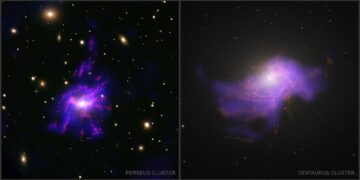Black holes—those mysterious, invisible giants—have long fascinated astronomers and captivated the public’s imagination. Often portrayed as cosmic devourers, these celestial objects are far more dynamic and complex than we once thought. New research using NASA’s Chandra X-ray Observatory and the Very Large Telescope (VLT) has revealed a surprising insight: black holes don’t just passively consume matter; they actively create conditions to sustain themselves.
How Black Holes Sustain Themselves
At the heart of galaxy clusters lie some of the most massive black holes in existence, with masses millions to billions of times greater than the Sun. These black holes aren’t just dormant behemoths; they are the engines driving powerful jets of energy into their surroundings. But what fuels these black holes, and how do they maintain such intense activity?
The answer lies in the gas that surrounds them. Observations of seven galaxy clusters revealed a fascinating pattern: jets emitted by black holes create turbulence in the surrounding gas, causing it to cool and condense into long, thread-like filaments of warm gas. These filaments act as highways, channeling gas directly into the black hole’s core. This inflow of material triggers a burst of activity—jets and energy are expelled, stirring the surrounding gas, starting the cycle again.
This self-sustaining process is akin to a cosmic “recycling plant.” The black hole expels energy, which disrupts and cools the surrounding environment, creating the very conditions it needs to feed. In turn, this gas fuels the black hole’s next outburst, creating a perpetual feedback loop that keeps both the black hole and its host galaxy active.
Gas Filaments: More Than Just Black Hole Fuel
While these gas filaments are vital for feeding black holes, they also play a crucial role in another fundamental cosmic process: star formation. As gas cools and condenses into filaments, it sometimes reaches a critical point where new stars can form. This means that the same gas feeding a black hole can also seed the birth of new stars in its galaxy.
Interestingly, these filaments have been compared to the gas “tails” seen in jellyfish galaxies. In such galaxies, gas is stripped away by external forces as the galaxy moves through its environment, creating long trails of material. These tails often serve as star-forming regions, much like the filaments surrounding black holes in galaxy clusters. The similarities between these two phenomena suggest a universal process at work, linking the evolution of galaxies across different scales and environments.
This discovery not only highlights the interconnected nature of the cosmos but also challenges previous assumptions about how galaxies evolve. Far from being destructive forces, black holes actively contribute to the growth and evolution of their host galaxies, demonstrating a delicate balance between consumption and creation.
Unlocking the Universe with Advanced Technology
The breakthrough in understanding this feedback loop was made possible by cutting-edge technology and innovative techniques. The Chandra X-ray Observatory captured emissions from the hot gas surrounding black holes, while the VLT’s MUSE instrument provided detailed maps of the cooler gas filaments. By combining these data sources, researchers were able to isolate the filaments from other structures, such as large cavities in the hot gas created by black hole jets.
This precise mapping revealed a direct correlation: regions where the hot gas was brighter also showed brighter warm gas filaments. This relationship confirmed the role of black hole outbursts in cooling and condensing the surrounding gas, providing the first concrete evidence of this self-sustaining cycle.
Such advancements in technology are revolutionizing our ability to study the universe. Instruments like Chandra and MUSE allow astronomers to peer deeper into cosmic processes, uncovering details that were once invisible. As new telescopes come online, including the James Webb Space Telescope (JWST) and the Extremely Large Telescope (ELT), our understanding of black holes and their role in shaping the cosmos is set to expand even further.
Why This Discovery Matters
The discovery of this feedback loop is a major milestone in understanding how black holes influence their environments. Galaxy clusters, which are massive structures containing thousands of galaxies bound by gravity, are profoundly shaped by the activity of their central black holes. By regulating the flow of gas, black holes control the growth of galaxies and the formation of new stars, acting as cosmic architects.
This study also provides insights into the broader mechanisms that govern the universe. The parallels between black hole filaments and jellyfish galaxies suggest that similar physical processes occur across vastly different settings. This universality points to underlying principles that guide cosmic evolution, offering a unified framework for understanding how galaxies form, evolve, and interact.
Expanding the Frontiers of Research
This discovery is just the beginning. With next-generation telescopes and instruments, scientists are poised to explore these processes in even greater detail. The JWST, for example, will provide unprecedented views of the early universe, allowing researchers to study how black hole feedback influenced the formation of the first galaxies. Meanwhile, the ELT will offer high-resolution observations of nearby galaxy clusters, shedding light on the intricate interactions between black holes and their environments.
Future research will also focus on understanding the role of turbulence in cooling gas and forming filaments. By simulating these processes, scientists can refine their models of galaxy evolution and test new hypotheses.
Cosmic Connections: Black Holes, Stars, and Galaxies
One of the most fascinating aspects of this discovery is the connection it reveals between seemingly disparate phenomena. The similarities between black hole filaments and jellyfish galaxy tails highlight the universality of certain cosmic processes, showing how the same principles can manifest in different ways across the universe.
Conclusion
The discovery of black holes creating their own feedback loops has transformed our understanding of these enigmatic objects. Far from being mere consumers of matter, black holes actively shape their surroundings, cooling and recycling gas, driving star formation, and influencing galaxy evolution.
Reference:
Valeria Olivares et al, An Hα–X-ray surface-brightness correlation for filaments in cooling-flow clusters, Nature Astronomy (2025). DOI: 10.1038/s41550-024-02473-8



















